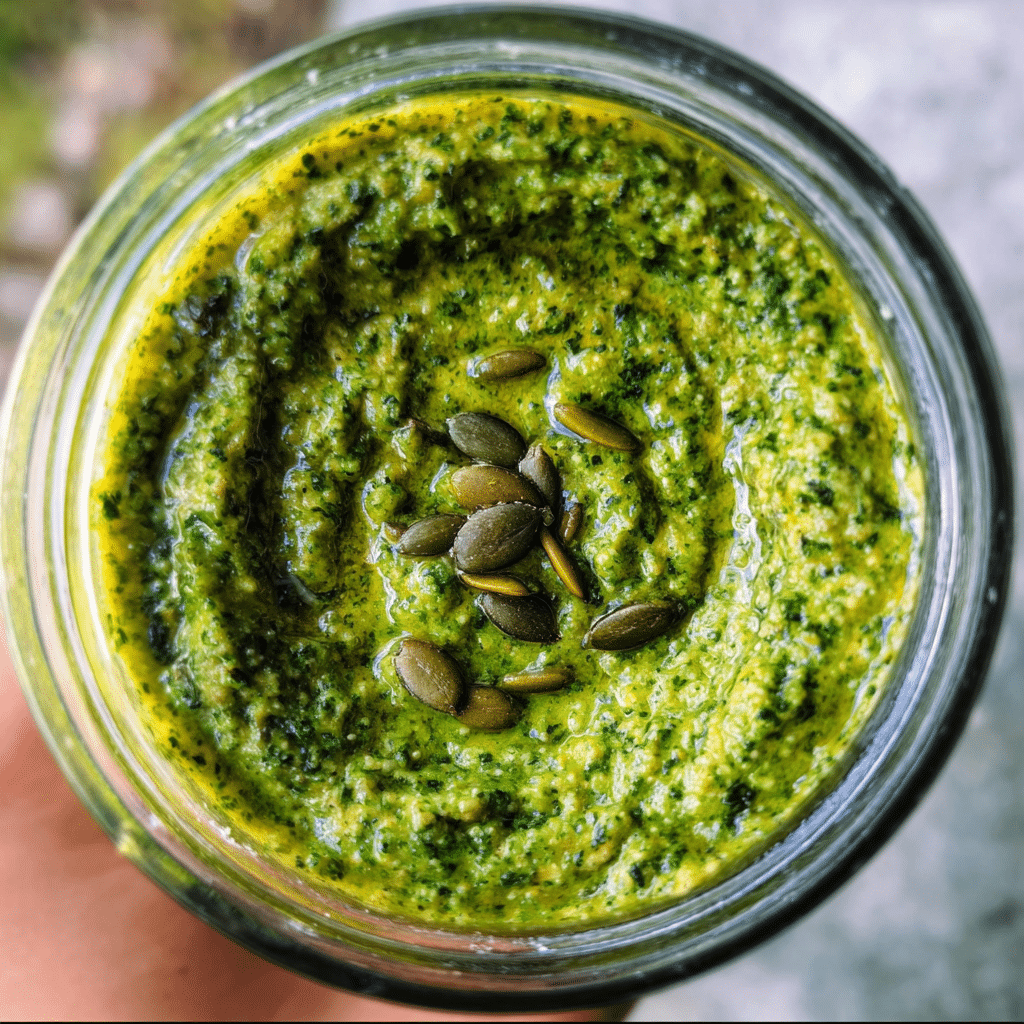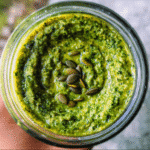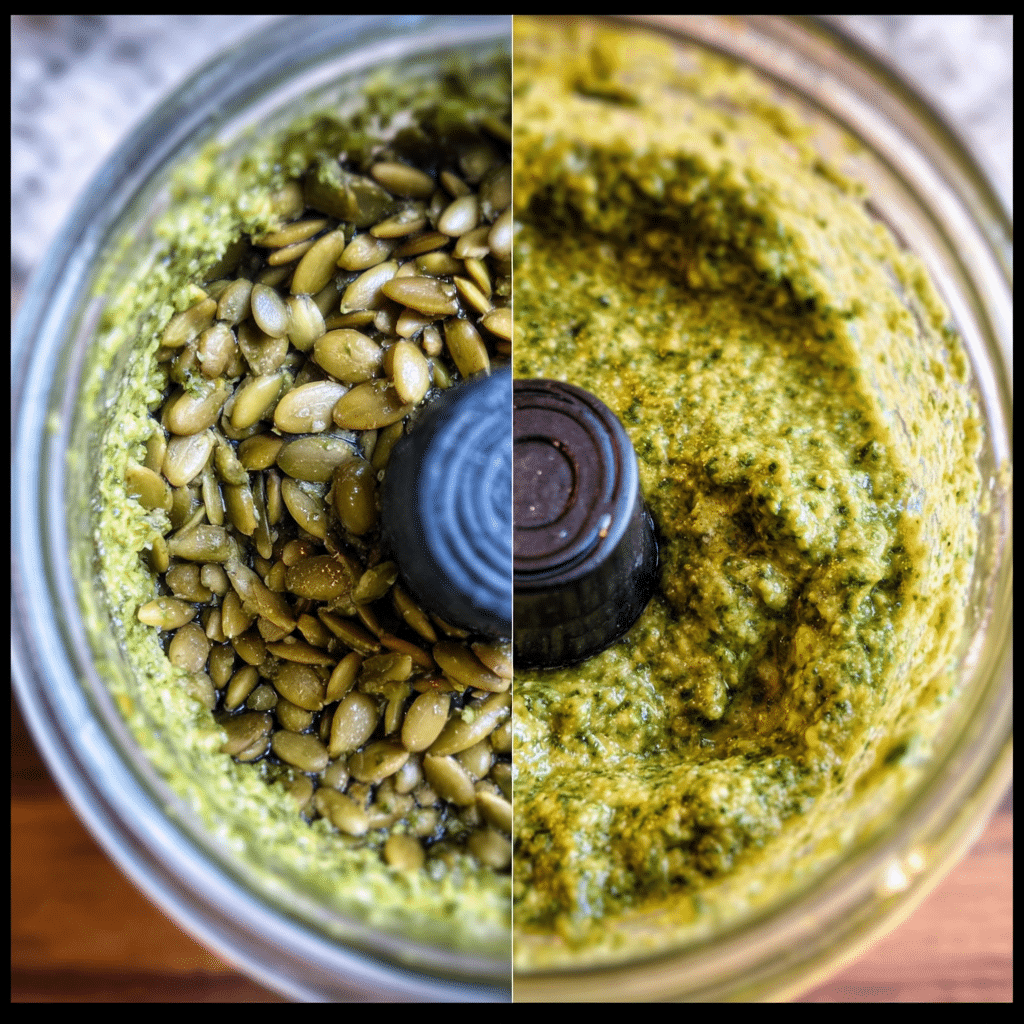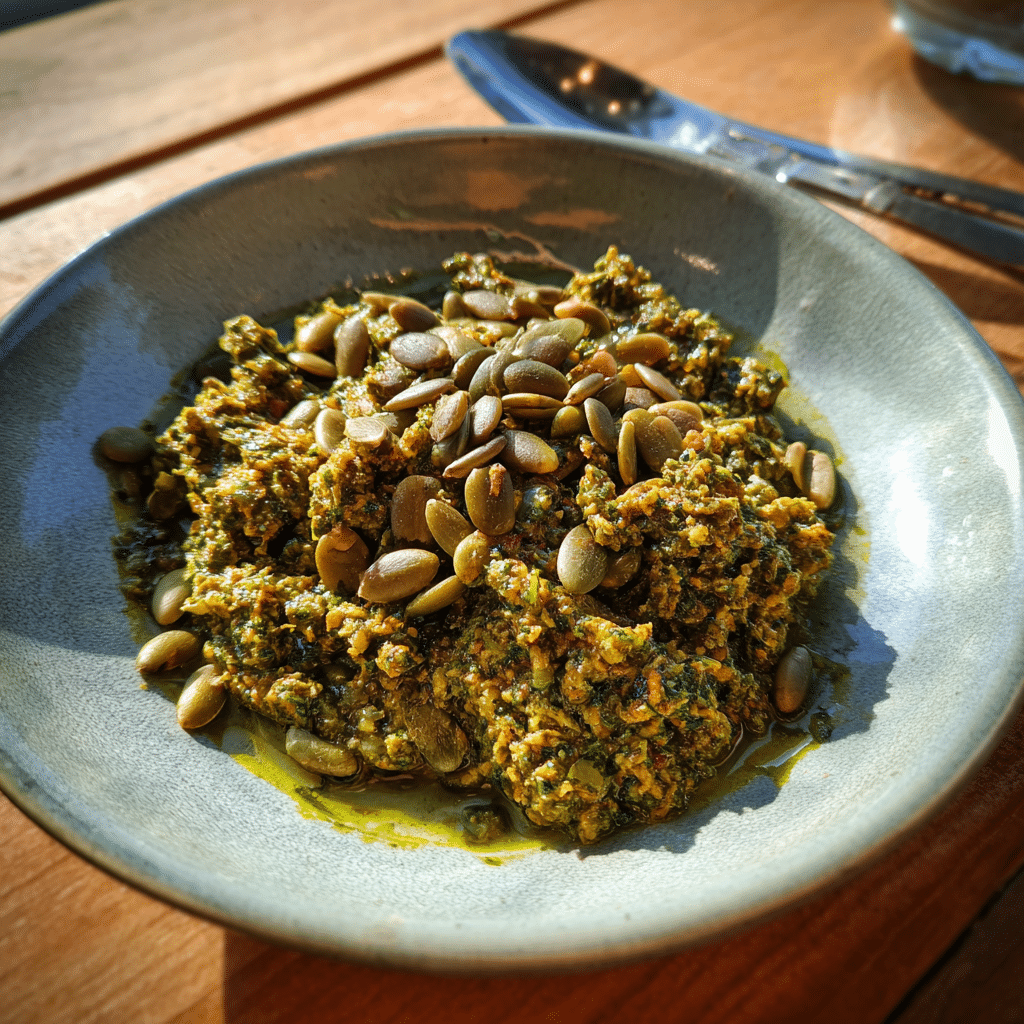Pumpkin seed pesto is a delightful and versatile sauce that packs a punch of flavor while being nut-free. My journey to discovering this unique recipe began on a crisp autumn day, surrounded by the vibrant colors of falling leaves. I was at a local farmer’s market, basking in the scent of spices, fresh herbs, and vegetables. While perusing the stalls, I stumbled upon a vendor selling roasted pumpkin seeds. Intrigued, I struck up a conversation with the owner, who shared with me her family’s favorite recipe for pumpkin seed pesto. Little did I know that this simple yet rich concoction would become a staple in my kitchen and a cherished dish for my family.

As I began experimenting with the recipe, I found that pumpkin seed pesto offered a delightful alternative to traditional pesto, which often includes nuts like pine nuts or walnuts. The flavor profile of pumpkin seeds, with their nutty and slightly sweet taste, paired beautifully with fresh herbs, garlic, and olive oil. I loved how this recipe not only catered to those with nut allergies but also provided an opportunity to enjoy a deliciously unique sauce that could be used in various dishes.
The Story Behind This Recipe
One of the things that make pumpkin seed pesto special is its cultural roots. While traditional pesto hails from Italy, pumpkin seed pesto has its origins in various regions where pumpkin seeds are harvested, particularly in Central and South America. These regions have a long history of using pumpkin seeds, or “pepitas,” in their cuisine, often incorporating them into sauces and spreads. The versatility of pumpkin seeds lends itself to many culinary applications, and as I dug deeper into the history, I learned how this simple ingredient transcended borders and blended with local flavors.
This recipe is not just a meal; it’s a celebration of the harvest, a nod to the seasonal bounty. It’s perfect for busy families looking for quick dinner solutions because it comes together in mere minutes. Simply blend the ingredients in a food processor, and you have a vibrant sauce that can elevate pasta, sandwiches, or even grilled vegetables. When evenings get hectic, this pumpkin seed pesto is a lifesaver, allowing you to whip up a nutritious and delicious meal in no time.
Seasonally, pumpkin seed pesto shines during the fall, when pumpkins are in abundance. However, it can be enjoyed year-round, reminding us of those crisp autumn days no matter the season. I often find myself making a big batch in the fall, freezing portions for later use. When I pull it out during the busy winter months, it brings a warm sense of nostalgia and comfort, evoking memories of family gatherings and cozy dinners.
What truly resonates with me about pumpkin seed pesto is the emotional connection it fosters. Cooking is often about more than just sustenance; it’s about creating memories and sharing experiences with loved ones. This dish has become a family favorite, and I take pride in passing down the recipe to my children, teaching them about the cultural significance and the simple joy of making a meal from scratch.
In this article, you’ll learn how to make pumpkin seed pesto, explore its rich history and cultural significance, and discover some delicious ways to incorporate it into your meals. Whether you’re a seasoned chef or just starting your culinary journey, I promise you’ll find joy and satisfaction in creating this nut-free alternative to traditional pesto.
The Rich History and Cultural Significance of pumpkin seed pesto
The rich history and cultural significance of pumpkin seed pesto are woven into the fabric of culinary traditions across various regions. This nut-free alternative to traditional pesto is not only a delicious option for those with nut allergies but also a testament to the versatility of pumpkin seeds, known as “pepitas.” The origins of pumpkin seed pesto can be traced back to the indigenous peoples of the Americas, where the cultivation of pumpkins and their seeds has ancient roots.
Origins and History
Pumpkin seeds have been utilized in cooking for thousands of years, particularly in Central and South America. The Aztecs and Mayans revered the pumpkin seed, using it in various dishes and as a source of sustenance. The practice of grinding seeds into a paste or sauce dates back to these ancient civilizations, and it is believed that variations of pumpkin seed pesto emerged as a natural evolution of this culinary tradition.
As European settlers arrived in the Americas, they encountered the pumpkin and its seeds, integrating them into their own cuisines. Over time, the recipe for pumpkin seed pesto began to take shape, influenced by local ingredients and culinary techniques. In regions where pumpkins thrived, such as Mexico, pumpkin seed sauces became a popular accompaniment to meats, vegetables, and tortillas. This adaptation laid the groundwork for the modern interpretations of pumpkin seed pesto that we enjoy today.
Cultural Significance
In many Latin American cultures, pumpkin seed-based sauces are a staple, especially during festive occasions. Mole, a traditional Mexican sauce, often includes ground pumpkin seeds among its myriad of ingredients. The cultural significance of these sauces goes beyond mere flavor; they are a way of honoring heritage, celebrating community, and preserving traditions passed down through generations. Today, pumpkin seed pesto is embraced not only in Latin American kitchens but also in diverse culinary traditions worldwide, showcasing the adaptability of this beloved ingredient.
Famous chefs and restaurants have also recognized the allure of pumpkin seed pesto, incorporating it into their menus to provide a unique twist on traditional dishes. You might find it served alongside grilled fish, slathered on artisan bread, or used as a vibrant dip for fresh vegetables. The versatility of pumpkin seed pesto makes it suitable for various occasions, whether it’s a casual family dinner or an elegant gathering with friends.
Nutritional Benefits
Beyond its cultural and historical significance, pumpkin seed pesto is also a nutritional powerhouse. Pumpkin seeds are rich in essential nutrients, including magnesium, zinc, and antioxidants. They provide a good source of protein and healthy fats, making pumpkin seed pesto a wholesome addition to any meal. The combination of fresh herbs, garlic, and olive oil enhances the dish’s health benefits, offering anti-inflammatory properties and promoting heart health.
As someone who values the importance of nutritious meals, I’ve found that incorporating pumpkin seed pesto into our family diet has not only added flavor but also boosted our overall health. It’s a fantastic way to sneak in greens and healthy fats, especially for picky eaters who may shy away from vegetables. Watching my children enjoy a serving of pasta topped with this vibrant green sauce fills me with joy, knowing that they are nourishing their bodies while also exploring new flavors.
In conclusion, pumpkin seed pesto is more than just a flavorful condiment; it’s a celebration of culinary history, cultural significance, and nutritional richness. By embracing this nut-free alternative to traditional pesto, we honor the traditions of those who came before us while creating new memories in our kitchens. As we delve deeper into the art of making pumpkin seed pesto, let us appreciate the journey it has taken to reach our tables and the joy it brings to our meals.
Essential Ingredients for Perfect pumpkin seed pesto
When it comes to making a delicious and vibrant pumpkin seed pesto, the ingredients you choose can make all the difference. This nut-free alternative is not only packed with flavor but also brings a unique twist to the traditional pesto. Let’s dive into the essential ingredients that will transform your pumpkin seed pesto into a culinary masterpiece.
Essential Ingredients
- Raw Pumpkin Seeds (Pepitas) – 1 cup: The star of the show, pumpkin seeds are rich in healthy fats, protein, and magnesium. Look for raw, unsalted seeds to ensure the freshest flavor. Toasting them lightly can enhance their nutty taste.
- Fresh Basil – 2 cups (packed): Basil adds a fragrant, herbal note to your pesto. Choose vibrant, green leaves without any wilting or browning. Fresh basil is typically available in the summer months, but you can find it year-round in many grocery stores.
- Garlic – 2 cloves: Garlic provides a pungent kick to the pesto. Fresh garlic is always preferable, as it has a much more pronounced flavor compared to pre-minced versions. Look for firm cloves with no signs of sprouting.
- Extra Virgin Olive Oil – ½ cup: A high-quality extra virgin olive oil is essential for a rich and smooth pesto. It enhances the flavors of the other ingredients. Choose an oil that has a fruity aroma and a peppery finish for the best results.
- Lemon Juice – 2 tablespoons: Freshly squeezed lemon juice adds brightness and acidity to balance the richness of the oil and seeds. Always opt for fresh lemons rather than bottled juice for the best flavor.
- Parmesan Cheese – ½ cup (grated): For those who include dairy in their diets, freshly grated Parmesan adds a savory umami flavor. If you’re looking for a nut-free or vegan option, you can skip this or substitute with nutritional yeast.
- Salt – to taste: Salt enhances all the flavors in your pesto. Start with a small amount and adjust according to your preference.
Every ingredient in this list plays a vital role in developing the unique flavor profile of your pumpkin seed pesto. The combination of fresh basil and garlic creates a classic pesto foundation, while the pumpkin seeds offer a creamy texture and nutty flavor without the allergens that come with traditional nuts.
Print
Pumpkin Seed Pesto (Nut-Free)
Ingredients
- ½ cup toasted pumpkin seeds
- 1 cup fresh basil
- ½ cup fresh parsley (stems are ok to include)
- 2 Tablespoons fresh lemon juice
- 2 cloves garlic, peeled
- ½ cup finely grated parmesan
- ½ cup extra virgin olive oil
- Salt and pepper to taste
Instructions
- Add the toasted pumpkin seeds, basil, parsley, lemon juice, garlic and parmesan to a food processor and blitz
- While the food processor is running, slowly pour in the extra virgin olive oil and continue blending until you get an even consistency (you are looking for fine chunks). You may have to stop the food processor and scrape the sides down a couple of times
- Have a taste and then season with salt and pepper to your liking
Shopping Tips
When shopping for these ingredients, consider visiting local farmers’ markets or specialty grocery stores for the freshest produce and high-quality oils. Look for organic options when possible, especially for basil and garlic, as they tend to have more robust flavors.
For pumpkin seeds, check the packaging for freshness. They should be free of any rancid or off smells and should have a pleasant nutty aroma. Always check the expiration date on packages to ensure quality.
Substitutions and Alternatives
For those with dietary restrictions or preferences, there are several substitutions you can consider:
- Pumpkin Seeds: If you cannot find pumpkin seeds, sunflower seeds can be a great alternative, providing a similar texture and flavor profile.
- Parmesan Cheese: For a dairy-free option, nutritional yeast can mimic the cheesy flavor without using dairy. Additionally, there are vegan Parmesan cheeses available in many stores.
- Basil: If fresh basil is out of season, you can use other herbs like parsley, spinach, or arugula, though the flavor will differ.
After gathering your ingredients, consider how to store them properly. Fresh basil should be kept in a cool spot, ideally in a glass of water, like a bouquet, to keep it fresh for longer. Unused pumpkin seeds can be stored in an airtight container in a cool, dark place, or in the refrigerator for extended freshness.
As you prepare your pumpkin seed pesto, keep in mind that quality matters. Investing in high-quality ingredients not only enhances the final product but also makes the cooking experience more enjoyable. As someone who has experimented with various pesto recipes over the years, I can assure you that the right ingredients can turn a simple dish into a delightful feast!
Detailed Step-by-Step pumpkin seed pesto Cooking Instructions
Now that we’ve gathered our ingredients for the pumpkin seed pesto, it’s time to roll up our sleeves and get cooking! The process is simple and straightforward, making it perfect for both novice cooks and seasoned chefs. With a total preparation time of about 30 minutes, you’ll have a vibrant, homemade pesto ready to enhance your meals.
Preparation Steps
- Gather Your Tools: Before you begin, assemble all the necessary tools. You will need a food processor, a spatula, measuring cups, and a cutting board. Having everything ready will streamline the cooking process.
- Prep the Ingredients: Rinse the fresh basil leaves gently under cold water and pat them dry with a paper towel. Peel the garlic cloves and set aside. If using fresh lemon juice, cut the lemon in half and use a juicer or your hands to squeeze out the juice.
- Measure Ingredients: Carefully measure out the pumpkin seeds, olive oil, and cheese (if using). Having everything pre-measured, or mise en place, will help you stay organized.
Cooking Process
- Toast the Pumpkin Seeds (Optional): For added depth of flavor, consider toasting the pumpkin seeds in a dry skillet over medium heat for about 5 minutes. Stir frequently to prevent burning. You’ll know they’re ready when they emit a fragrant, nutty aroma.
- Blend the Ingredients: In your food processor, combine the pumpkin seeds, basil, garlic, and salt. Pulse the mixture a few times until it’s finely chopped. This step is crucial as it breaks down the seeds and infuses the basil and garlic flavors.
- Add Olive Oil: While the food processor is running, slowly drizzle in the olive oil. This will help emulsify the mixture and create a creamy texture. Stop and scrape down the sides of the bowl occasionally to ensure everything is well incorporated.
- Incorporate Lemon Juice: Once the mixture is creamy and combined, add the fresh lemon juice. Pulse a few more times to blend it in. The lemon juice not only adds flavor but also helps preserve the vibrant green color of your pesto.
- Taste and Adjust: At this point, taste your pumpkin seed pesto and adjust the seasoning if needed. You might want to add more salt, lemon juice, or even a touch more olive oil depending on your preference.
Final Assembly
- Transfer to a Container: Once satisfied with the flavor, transfer the pesto to an airtight container. If you find your pesto is too thick, you can thin it out with a little more olive oil until you reach your desired consistency.
- Storage Tips: To keep your pesto fresh, cover the surface with a thin layer of olive oil before sealing the container. This will help prevent oxidation and maintain its vibrant color. Pumpkin seed pesto can be stored in the refrigerator for up to a week or frozen for longer storage.
- Discover Serving Suggestions: Your homemade pumpkin seed pesto can be enjoyed in numerous ways! Toss it with pasta, use it as a spread on sandwiches, or drizzle it over grilled vegetables or fish. The possibilities are endless!
Throughout my cooking journey, I’ve learned that the key to a successful dish lies not only in the ingredients but also in the process. Embrace each step, enjoy the aromas, and don’t hesitate to make adjustments that suit your palate. With this detailed guide, you’ll create a delicious pumpkin seed pesto that will impress your family and friends. Happy cooking!
Professional Tips and Techniques for pumpkin seed pesto
When it comes to crafting the perfect pumpkin seed pesto, there’s a world of techniques that can elevate this delightful sauce from good to extraordinary. Drawing from my own experiences in the kitchen, I’ve learned that mastering a few professional cooking tips can transform your homemade pesto into a culinary masterpiece.
Professional Techniques
First and foremost, let’s talk about the star of our pumpkin seed pesto: the pumpkin seeds themselves. Toasting them is a must! Not only does toasting enhance their natural nutty flavor, but it also adds a crunch that can take your pesto to the next level. Simply toss them in a dry skillet over medium heat, stirring frequently until they are golden brown. This process usually takes about 5-7 minutes, and the aroma that fills your kitchen is absolutely divine.
Another professional tip is to use the right type of oil. While you can certainly use olive oil, consider experimenting with other oils such as avocado or pumpkin seed oil for a unique flavor profile. Cold-pressed oils retain more nutrients and flavor, giving your pumpkin seed pesto an extra depth that you and your guests will appreciate.
Don’t forget the importance of a good blender or food processor. A high-quality appliance will ensure that your ingredients are blended smoothly, creating that luscious texture we all crave in a pesto. If you find your pesto is too thick, don’t hesitate to add a bit more oil or even a splash of water to achieve the consistency you desire.
Troubleshooting Guide
Even seasoned chefs run into hiccups while cooking, so let’s address some common issues you might face when making pumpkin seed pesto. One of the most frequent problems is a pesto that turns out too bitter. This can happen if you over-toast the pumpkin seeds or use rancid oil. Always keep an eye on your seeds while toasting, and ensure that your oils are fresh.
If your pesto is too oily, you might have added too much oil at once. Instead of panic, try adding more pumpkin seeds or a handful of fresh herbs to balance it out. On the other hand, if you find your pesto lacks flavor, a pinch of salt or a squeeze of lemon juice can work wonders, brightening up the flavors beautifully.
For those who might have allergies or dietary restrictions, the traditional cheese component can be swapped out for nutritional yeast, which provides that cheesy flavor without the dairy. This version is perfect for vegans or anyone looking to reduce dairy in their diet.
Presentation Tips
Once you’ve created your pumpkin seed pesto, presentation is key! Consider serving it in a small bowl drizzled with a bit of olive oil and topped with a sprinkle of toasted pumpkin seeds for that extra flair. Pair it with some fresh, crusty bread or vegetable crudités for an appetizer that looks as good as it tastes.
When plating, don’t shy away from creativity. A swirl of pesto on a plate can act as a beautiful sauce for grilled chicken or fish. Imagine a vibrant green swirl contrasting against the white of a plate, instantly making your dish more appealing. You can also serve it over pasta, where the pesto clings perfectly to the noodles, making for a visually stunning meal.

If you’re looking to elevate your dining experience even further, consider wine pairings. A crisp Sauvignon Blanc or a light-bodied Pinot Grigio complements the herbaceous notes of your pumpkin seed pesto beautifully. For a non-alcoholic option, a sparkling water with a splash of lemon provides a refreshing palate cleanser that works wonderfully with the richness of the pesto.
Finally, when it comes to meal prep, your pumpkin seed pesto can be made ahead and stored in the refrigerator for up to a week. Just be sure to cover it with a thin layer of oil to preserve its vibrant color. You can also freeze it in ice cube trays for easy portioning later on—perfect for adding a pop of flavor to soups, salads, or pasta dishes.
In conclusion, the art of making pumpkin seed pesto is filled with delightful techniques that can enhance your culinary repertoire. With a little patience, creativity, and these pro tips in mind, you’ll be on your way to impressing family and friends with a pesto that’s not just a sauce, but a celebration of flavors and textures.
Creative Variations and Adaptations of pumpkin seed pesto
While the classic pumpkin seed pesto is a delectable treat on its own, the beauty of cooking lies in its ability to evolve. With every season and cultural influence, there exists a plethora of variations and adaptations that you can explore. Let’s dive into some creative ideas that not only honor the original recipe but also open up new culinary adventures.
Seasonal Variations
One of the most exciting aspects of cooking is utilizing seasonal ingredients. During the summer months, consider adding fresh basil leaves to your pumpkin seed pesto. This aromatic herb pairs beautifully with the nutty flavor of pumpkin seeds, creating a classic pesto that’s perfect for tossing with pasta or drizzling over grilled vegetables.
As autumn rolls in, why not incorporate roasted butternut squash or sweet potatoes into your pesto? The natural sweetness of these vegetables complements the earthy pumpkin seeds, resulting in a creamy, vibrant sauce that’s a perfect match for hearty fall dishes. Simply roast your squash or potatoes until tender, then blend them in with the other ingredients.
In winter, you can experiment with kale or spinach for a nutrient-packed twist. Both greens can add a beautiful color and flavor to your pumpkin seed pesto, while also providing a robust dose of vitamins. This variation is perfect for spreading on warm, toasted bread or as a topping for baked potatoes.
Dietary Adaptations
As we navigate through various dietary restrictions, it’s essential to adapt our favorite recipes to ensure everyone can enjoy them. For those on a keto diet, consider swapping out traditional pasta for zucchini noodles and using olive oil as the base for a low-carb version of pumpkin seed pesto. The zucchini adds a refreshing crunch and pairs well with the rich flavors of the pesto.
If you’re catering to a vegan crowd, simply omit any cheese and use nutritional yeast instead. This ingredient not only provides a cheesy flavor but is also packed with B vitamins. Make sure to check labels and choose brands that are gluten-free if you’re serving guests with gluten sensitivities, ensuring that everyone at your table can indulge in your culinary creation.
Creative Twists
When it comes to adding a twist to your pumpkin seed pesto, don’t shy away from experimenting with flavors. Try infusing your pesto with roasted garlic for an added depth of flavor. Simply roast a whole bulb of garlic until caramelized, and blend it into your pesto for a sweet, complex taste that will have your guests raving.
If you’re in the mood for something spicy, consider adding a few slices of jalapeño or a sprinkle of crushed red pepper flakes to your batch. This will bring a delightful heat that pairs beautifully with the nuttiness of the pumpkin seeds. Alternatively, for a hint of sweetness, mix in some sundried tomatoes; their tangy flavor can brighten your pesto and provide a beautiful color contrast.
Finally, consider different cooking methods to prepare your pumpkin seed pesto. While the traditional method involves blending ingredients raw, you can also try roasting the seeds and garlic before blending for a deeper flavor profile. Some adventurous cooks even make a slow-cooked version, allowing the flavors to meld together over time, resulting in a rich and complex sauce.
Leftover transformations are another exciting way to make the most out of your pumpkin seed pesto. If you find yourself with a bit too much, it can be used as a flavorful marinade for meats or a dressing for salads. You can even swirl it into soups for a creamy finish or use it as a topping for homemade pizzas, giving your dish an unexpected burst of flavor.
In summary, the variations of pumpkin seed pesto are limited only by your imagination. By incorporating seasonal ingredients, adapting to dietary needs, and adding your unique twists, you can create endless versions of this versatile sauce. Each variation not only celebrates the original recipe but also allows you to explore new culinary landscapes, keeping your cooking fresh and exciting.
Storage, Reheating, and Meal Prep for pumpkin seed pesto
When it comes to preserving the vibrant flavors of pumpkin seed pesto, understanding the best storage techniques can make all the difference. Whether you’ve made a big batch to elevate your pasta dishes or simply want to enjoy a spoonful here and there, knowing how to store your pumpkin seed pesto can help maintain its freshness and quality for weeks to come.
Short-term Storage
The first step in storing your pumpkin seed pesto is short-term storage, which is perfect if you plan to consume it within a week. Once you’ve blended your pesto to creamy perfection, transfer it into an airtight container. Glass jars are a fantastic choice because they not only keep the pesto fresh but also allow you to see the beautiful green hue that makes this sauce so appealing.
Before sealing the jar, drizzle a thin layer of olive oil over the surface of the pesto. This creates a barrier that helps prevent oxidation, keeping your pumpkin seed pesto from turning brown. Seal the container tightly and place it in the refrigerator. Properly stored, your pesto should last about 5 to 7 days in the fridge.
When you’re ready to use your pumpkin seed pesto, simply scoop out the desired amount with a clean spoon to avoid introducing bacteria into the container. This small step will help ensure that your pesto remains delicious throughout its short shelf life.
Freezing and Long-term Storage
If you’ve made a larger batch of pumpkin seed pesto or simply want to prepare ahead for future meals, freezing is the way to go. Freezing maintains the vibrant flavors and nutritional properties of the pesto while extending its shelf life to about 3 to 6 months.
To freeze your pumpkin seed pesto, start by portioning it into an ice cube tray. This allows you to create small, convenient servings that can be easily thawed as needed. Once the pesto is frozen solid, pop the cubes out and transfer them into a resealable plastic bag or an airtight container. Be sure to label the bag with the date and contents to keep track of its freshness.
Alternatively, you can freeze your pesto in larger containers, but remember that it may take longer to thaw. When you’re ready to use your frozen pumpkin seed pesto, simply remove the amount you need and let it thaw in the refrigerator overnight or place it in a bowl of warm water for quicker thawing.
Reheating Best Practices
While you don’t technically “reheat” pesto in the traditional sense, there are methods to incorporate it into your dishes without compromising its fresh flavor. The key is to add the pumpkin seed pesto to your warm dishes at the last minute. For example, if you’re tossing it with pasta, wait until the pasta is fully cooked and drained. Then, add the pesto while the pasta is still warm, allowing the heat to gently warm the pesto without cooking it.
Avoid adding pesto to boiling hot dishes, as high heat can diminish its fresh taste and vibrant color. If you’re using it as a dip or spread, simply allow it to reach room temperature before serving, ensuring that the flavor profile remains intact.
For meal prep enthusiasts, pumpkin seed pesto is a versatile ingredient that can elevate various dishes. You can prepare a batch at the beginning of the week and use it in salads, grain bowls, or as a sandwich spread. Consider portioning the pesto into small containers for an easy grab-and-go option for lunches or quick dinners.
Food safety is paramount when storing any homemade dish, including your pumpkin seed pesto. Always use clean utensils when scooping out pesto, and if you notice any signs of spoilage, such as an off smell or change in color, it’s best to err on the side of caution and discard it. By following these storage and meal prep tips, you can enjoy your pumpkin seed pesto at its best!
Nutritional Benefits and Health Information
Delving into the nutritional benefits of pumpkin seed pesto reveals that this delightful sauce is not just a flavorful addition to your meals, but also a powerhouse of health benefits. With its unique combination of ingredients, pumpkin seed pesto can support your dietary needs while tantalizing your taste buds.
Nutritional Profile
At its core, pumpkin seed pesto is typically made from a base of pumpkin seeds, olive oil, garlic, and fresh herbs like basil or parsley. Each of these ingredients brings its own set of nutrients to the table. A typical serving of pesto (about 2 tablespoons) contains approximately 100 calories, with a macronutrient distribution that is rich in healthy fats and moderate in protein and carbohydrates.
The primary source of fat in pumpkin seed pesto comes from the olive oil and pumpkin seeds, both of which are heart-healthy. Pumpkin seeds, in particular, are loaded with essential fatty acids, making them a great source of energy. Additionally, they contain roughly 5 grams of protein per serving, contributing to your daily protein needs.
In terms of vitamins and minerals, pumpkin seeds are a treasure trove. They are particularly high in magnesium, zinc, and iron. Magnesium plays a vital role in over 300 biochemical reactions in the body, including muscle and nerve function, while zinc is essential for immune health and iron is crucial for oxygen transport in the blood.
Health Benefits
The health benefits of pumpkin seed pesto extend beyond its nutrient profile. The antioxidants found in pumpkin seeds, such as vitamin E and carotenoids, can help combat oxidative stress, reducing the risk of chronic diseases. The healthy fats from the olive oil not only improve heart health but can also aid in the absorption of fat-soluble vitamins.
The combination of garlic in your pesto can also provide numerous health benefits. Garlic has been known for its anti-inflammatory properties and may support heart health by lowering blood pressure and cholesterol levels. Plus, it adds a delicious depth of flavor to your pumpkin seed pesto that makes it irresistible.

Dietary Considerations
For those with dietary restrictions, pumpkin seed pesto is an excellent option. As it is nut-free, it can be enjoyed by individuals with nut allergies without any concerns. Additionally, it is gluten-free, making it suitable for those on a gluten-free diet. Its plant-based ingredients also make it a fantastic choice for vegans and vegetarians.
When considering dietary modifications, you can easily adjust the recipe to suit your needs. For a lower-calorie option, try reducing the amount of oil. Alternatively, if you’re looking to boost the protein content, consider adding nutritional yeast, which also lends a cheesy flavor to the pesto. This can be especially appealing for those on a dairy-free diet.
In comparison to traditional pesto, which often uses pine nuts, pumpkin seed pesto provides a unique flavor profile and is often more budget-friendly. Pine nuts can be quite expensive and less accessible in some regions, making pumpkin seeds a fantastic alternative that doesn’t skimp on taste or nutrition.
In conclusion, incorporating pumpkin seed pesto into your meals not only adds a delicious burst of flavor but also brings a wealth of health benefits. Whether you’re drizzling it over roasted vegetables, tossing it with pasta, or using it as a sandwich spread, you’re making a smart choice for your health. The next time you whip up a batch, remember that you’re not just treating yourself to a tasty condiment; you’re also nourishing your body with every bite!
Frequently Asked Questions About Pumpkin Seed Pesto
Pumpkin seed pesto nut free vegan
Pumpkin seed pesto is an excellent nut-free vegan alternative to traditional pesto, utilizing pumpkin seeds as the main ingredient for a creamy texture and rich flavor. To make it, simply blend together roasted pumpkin seeds, fresh basil, garlic, nutritional yeast, lemon juice, and olive oil until smooth. This combination not only mimics the taste of classic pesto but also packs a protein punch without any nuts. For an added twist, consider incorporating some nutritional yeast for a cheesy flavor, and adjust the consistency with more olive oil or water as needed. Serve it over pasta, drizzle it on salads, or use it as a savory spread on sandwiches.
Pumpkin seed pesto nut free recipe
To create a delicious nut-free pumpkin seed pesto, gather the following ingredients: 1 cup of raw pumpkin seeds, 2 cups of fresh basil leaves, 2 cloves of garlic, 1/4 cup of nutritional yeast, the juice of one lemon, and 1/2 cup of extra-virgin olive oil. First, toast the pumpkin seeds in a dry skillet until they are golden and fragrant, which enhances their flavor. Then, combine all ingredients in a food processor and blend until smooth, scraping down the sides as needed. Taste and adjust seasoning with salt and pepper or more lemon juice for brightness. This versatile pesto can be stored in an airtight container in the refrigerator for up to a week, making it a great make-ahead option.
Pumpkin seed pesto nut free healthy
Pumpkin seed pesto is not only nut-free but also a healthy choice packed with nutrients. Pumpkin seeds are rich in magnesium, zinc, and healthy fats, which contribute to heart health and overall wellbeing. By using fresh basil and garlic, this pesto also provides antioxidant benefits and anti-inflammatory properties. Additionally, opting for olive oil as your fat source introduces monounsaturated fats that support cholesterol levels. To make it even healthier, consider incorporating leafy greens like spinach or kale for added vitamins and minerals without compromising flavor.
Vegan pumpkin seed pesto
Vegan pumpkin seed pesto is a fantastic way to enjoy a flavor-packed sauce without any animal products. To prepare it, blend together 1 cup of raw pumpkin seeds, 2 cups of fresh basil, 2 cloves of garlic, 1/4 cup of nutritional yeast, and 1/2 cup of olive oil until the mixture reaches a smooth consistency. This pesto is not only vegan but also versatile; it can be used in pasta dishes, as a dip for veggies, or as a topping for grilled proteins. For a unique twist, try adding roasted red peppers or sun-dried tomatoes for an added layer of flavor and color.
Conclusion: Mastering the Perfect pumpkin seed pesto
Creating the perfect pumpkin seed pesto is more than just following a recipe—it’s about understanding the techniques, ingredients, and cultural significance behind this beloved dish. Throughout this comprehensive guide, we’ve explored everything from the historical origins to modern variations, ensuring you have all the knowledge needed to make this recipe your own.
Whether you’re a beginner cook or an experienced chef, the techniques and tips we’ve shared will help you create a pumpkin seed pesto that’s not only delicious but also meaningful. Remember that cooking is a journey of discovery, and each time you make this dish, you’ll learn something new.
We encourage you to experiment with the variations we’ve discussed, adapt the recipe to your dietary needs, and most importantly, share it with the people you love. Food has the incredible power to bring people together, and Pumpkin Seed Pesto (Nut-Free) is the perfect dish to create lasting memories around your dinner table.





